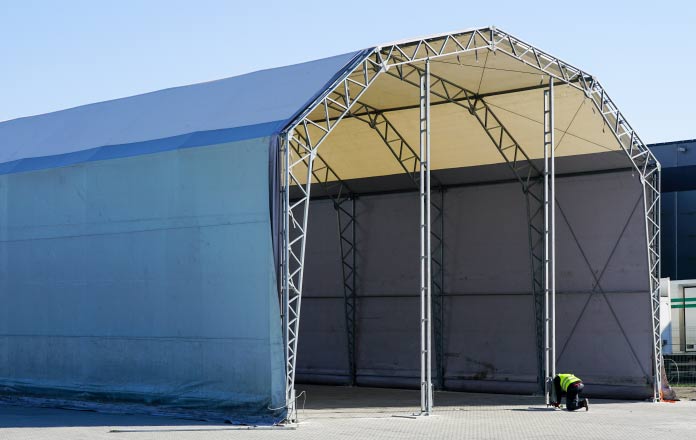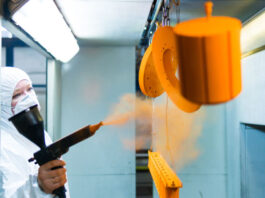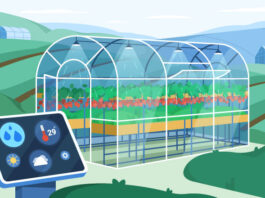Fabric buildings are an increasingly popular choice for many applications, from warehouses and industrial facilities to event venues and temporary structures. These buildings offer many advantages over traditional brick-and-mortar construction. They are cost-effective, durable, easy to erect and dismantle, and you can configure them into about any size or shape.
However, with so many options on the market, it’s vital to comprehend the essential factors to consider when selecting the suitable fabric building for your needs. This article examines the elements that go into choosing the optimal fabric building. Read on!
-
Consider The Intended Use
When choosing a fabric building, the most crucial factor is how you plan to use it. This is because different purposes call for varying features. For instance, if you want a gym, look for high ceilings and open spaces for sports and activities. On the contrary, excellent ventilation is crucial when the intended use is storing hay to keep it dry and prevent mold.
Consider your needs in terms of required space, ceiling height, and accessibility. This will help you select fabric structures optimally suited to your needs. Do you need wide halls and ramps for equipment, or are unique surfaces for heavy machinery essential? Asking these questions upfront ensures you get a building tailored to your specific needs, saving time and money down the road.
-
Evaluate Structural Integrity And Design
A building’s structural integrity ensures its longevity and safety. When evaluating fabric buildings, consider the engineering behind the structure. You’d want something durable that’ll withstand your area’s weather and last for years to come.
Look at the frame material; steel and aluminum provide excellent strength and longevity. For example, seek out fabric buildings engineered for heavy snow loads or high winds if those are factors in your location. In earthquake zones, the frame needs reinforced joints and footings.
Also, consider a building with easy expansion capabilities, using modular construction or a frame to accommodate future growth. An adaptable design saves money on additions down the road.
-
Examine Fabric Material
When selecting the outer fabric for your building, you have several material options to consider. They include the following:
- PVC (Polyvinyl Chloride): PVC strikes an optimal balance between cost and performance. It resists fire better than cheaper fabrics and is more affordable than other materials. PVC also holds up well against weather, including sun, wind, rain, and snow, and its versatility allows it to suit most climates and functions, from equipment storage to athletic facilities. While not as indestructible as other polymers, PVC’s durability meets the needs of many applications
- PE (Polyethylene): For a lightweight, budget-friendly fabric building, consider polyethylene. It costs less than materials like PVC and PTFE, making it ideal for temporary shelters or short-term storage needs.
PE withstands weather well enough for limited use spanning a few seasons. Its lightweight composition requires minimal structural reinforcements, further reducing construction costs. It also comes in various opacities, allowing light filtration while protecting contents from sunlight damage.
- PTFE (Polytetrafluoroethylene): If you want a structure with unmatched durability under extreme conditions, PTFE fabric is an excellent option. It withstands intense heat, cold, sunlight, and chemical exposure better than any other polymer. Its nonstick surface prevents abrasion damage and sheds rain, snow, and debris. PTFE is cost-effective in the long term since it lasts for many years, outlasting cheaper materials several times over.
These are some of the common fabric structure materials available. To choose the best, consider your budget, needs, and timeline.

-
Consider Environmental Impact
Sustainability matters now more than ever as people are more positive and receptive to the green transition. Therefore, considering the structure’s environmental impact is crucial. Compared to traditional structures, fabric buildings are considered eco-friendly due to recyclable materials, natural light, and energy savings.
However, not all are equal in sustainability. So, seek manufacturers that utilize recycled content in their fabrics and frames. This reduces waste and helps the environment.
Ask about energy efficiency features like roof skylights and translucent panels to harness free natural light and minimize electricity for indoor lighting. Also, look for cool roof coatings that reflect sunlight and decrease heat absorption. A green building aligns with environmental values while providing a comfortable, cost-effective facility for years to come.
-
Compare The Cost Of The Fabric Buildings
While not the only consideration, cost plays a vital role when selecting a fabric building. Look beyond the purchase price and factor in installation, ground preparations, and operating costs over the lifecycle. A building that costs more upfront but lasts twice as long is often the better value.
Compare durability, energy efficiency, and maintenance needs between options to project the total cost of ownership. If your needs are short-term, cheaper shelters such as PE may suffice. However, long-term operations require higher grades like PVC and PTFE despite higher initial price tags.
With a complete understanding of installation, lifespan, maintenance, and efficiency, you can determine whether premium components pay dividends through performance and longevity or whether a budget-friendly structure meets your needs. Either way, a wise investment optimizes value by balancing cost against practicality.
-
Consider Customization Options
Another benefit of fabric buildings is the ability to customize them to your needs. Look for manufacturers that provide extensive customization options beyond standard sizes and models. You may require specific dimensions, door placement and quantities, window types and layouts, ventilation packages, electrical systems, insulation, partition walls, and storage solutions to create an optimal environment.
Custom doors suited to your use, whether oversized vehicle access or compliance with ADA (Americans with Disabilities Act) standards, maximize functionality. Skylights and window films that balance visibility, opacity, and ultraviolet protection let you control lighting and ambiance.
-
Research Building Codes And Permits
Before installing any fabric building, investigate permits and building codes for your area. Requirements vary depending on location, size, and usage. A small storage shed may not require a permit, while a large commercial facility must have the necessary licenses before installation. Common factors determining permit needs include dimensions, occupancy capacity, electrical systems, and whether the structure is permanent or temporary.
To fully understand the requirements for your specific project, connect with your local building department early in the planning process. Discuss factors like zoning, required inspections, and compliance with fire, construction, and energy standards. Submit permit applications promptly with all necessary documents, drawings, and fees to avoid delays.
If the process seems complex, consider hiring professionals to navigate permitting on your behalf. While permits and code compliance add steps, they ultimately ensure your building is safe. With diligent research and proactive communication, you can obtain approvals to construct a code-compliant fabric building suited to your needs successfully.
-
Evaluate Manufacturer Reputation And Warranty
When choosing a fabric building manufacturer, research their reputation and warranties carefully. A good warranty provides protection, but only if the company honors it. Look for an established brand with many years in business and numerous positive customer reviews.
This suggests they use quality materials and engineering to minimize failures and warranty claims. Testimonials, case studies, and third-party ratings also offer helpful insights into product durability and manufacturer support.
Be wary of obscure companies with no verifiable history or reviews – their cut-rate buildings likely cut corners. Reputable brands utilize premium components like steel frames, PVC or PTFE fabrics, and reinforced accessories. Investing in a quality manufacturer buys exceptional service and responsiveness for the building’s lifetime.
Conclusion
Selecting the right fabric building is a process that requires careful consideration of various factors. By taking the time to evaluate your needs, research options, and consult with professionals, you can ensure that your investment meets your requirements today and can adapt to your needs in the future. Remember, the ideal fabric building should meet your specific needs and provide optimal functionality, durability, and value for your investment.




